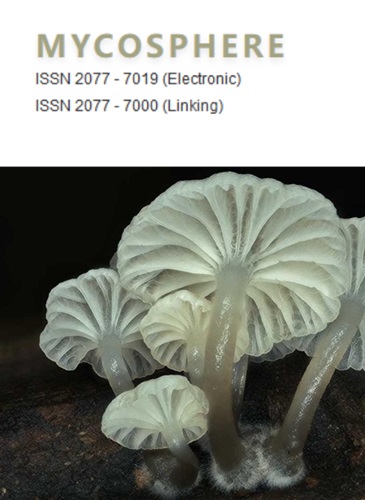Additions to Fissuroma and Neoastrosphaeriella (Aigialaceae, Pleosporales) from palms
IF 15.1
1区 生物学
Q1 MYCOLOGY
引用次数: 6
Abstract
Recent examination of palm fungi led to the discovery of a group of fissuroma-like taxa, which share the following morphological features: slit-like ascomata, carbonaceous peridium, trabeculate pseudoparaphyses, cylindric-clavate or obclavate asci and fusiform, septate ascospores. Multi-gene phylogenetic analyses based on a combined ITS, LSU, SSU and TEF1-α sequence data support the establishment of Fissuroma palmae sp. nov. and Neoastrosphaeriella phoenicis sp. nov. Fissuroma caryotae and N. aquatica are also recovered as new host records from terrestrial palms. Fissuroma palmae is phylogenetically close to F. caryotae with strong support, but differs from F. caryotae in the appearance of pale brown mature ascospores, and the dimensions of asci and ascospores. Neoastrosphaeriella phoenicis is associated with submerged petioles of Phoenix paludosa in mangroves, providing an insight of a new habitat for Neoastrosphaeriella species. The hyaline to pale brown, fusiform, 1–3-septate, guttulate, verrucose ascospores of N. phoenicis distinguish it from other existing Neoastrosphaeriella species. Additional new taxa and their morphological features, ecological occurrence, as well as phylogenetic circumscription of genera in Aigialaceae are provided and discussed.棕榈裂孢属和新星孢属的增补
最近对棕榈真菌的检查导致发现了一组裂隙样分类群,它们具有以下形态特征:裂隙样子囊,碳质包皮,小梁状假脊膜,圆柱状棒状或倒棒状的子囊孢子和纺锤状,分开的子囊孢子。基于ITS、LSU、SSU和TEF1-α序列数据的多基因系统发育分析支持了棕榈裂蝇(Fissuroma palmae sp. 11)和Neoastrosphaeriella phoenicis sp. 11的存在。棕榈裂孢在系统发育上与核仁裂孢相近,有较强的支撑力,但在浅棕色成熟子囊孢子的外观以及子囊孢子和子囊孢子的大小上与核仁裂孢不同。在红树林中,Neoastrosphaeriella phoenicis与paludosa凤凰的淹没叶柄有关,为Neoastrosphaeriella的新栖息地提供了新的认识。其透明到浅棕色,梭状,1 - 3-分隔,细管状,疣状的子囊孢子区别于其他现存的新星球孢子属物种。本文提供并讨论了艾菖蒲科的新分类群及其形态特征、生态发生和属的系统发育界限。
本文章由计算机程序翻译,如有差异,请以英文原文为准。
求助全文
约1分钟内获得全文
求助全文
来源期刊

Mycosphere
MYCOLOGY-
CiteScore
30.00
自引率
8.20%
发文量
9
审稿时长
4 weeks
期刊介绍:
Mycosphere stands as an international, peer-reviewed journal committed to the rapid dissemination of high-quality papers on fungal biology. Embracing an open-access approach, Mycosphere serves as a dedicated platform for the mycology community, ensuring swift publication of their valuable contributions. All submitted manuscripts undergo a thorough peer-review process before acceptance, with authors retaining copyright.
Key highlights of Mycosphere's publication include:
- Peer-reviewed manuscripts and monographs
- Open access, fostering accessibility and dissemination of knowledge
- Swift turnaround, facilitating timely sharing of research findings
- For information regarding open access charges, refer to the instructions for authors
- Special volumes, offering a platform for thematic collections and focused contributions.
Mycosphere is dedicated to promoting the accessibility and advancement of fungal biology through its inclusive and efficient publishing process.
 求助内容:
求助内容: 应助结果提醒方式:
应助结果提醒方式:


